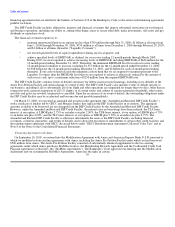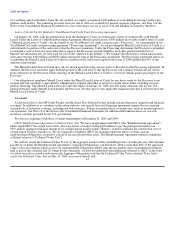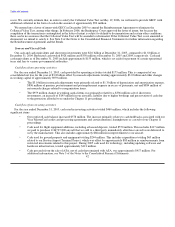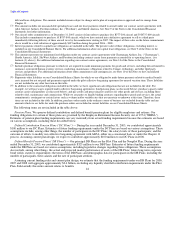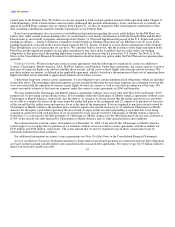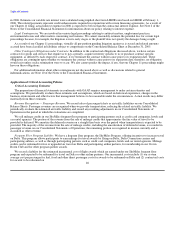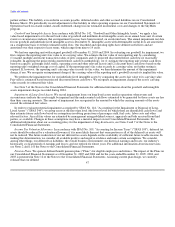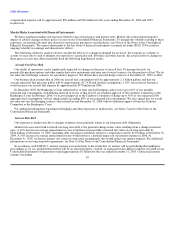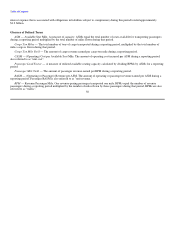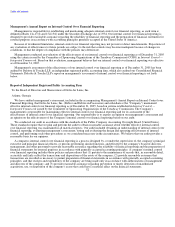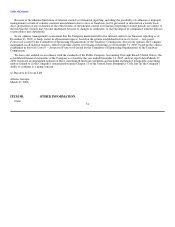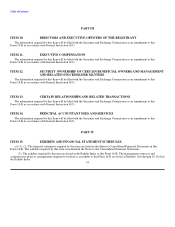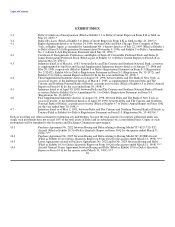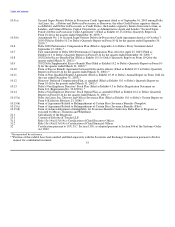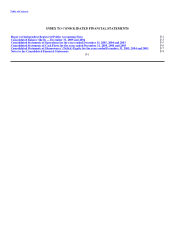Delta Airlines 2005 Annual Report Download - page 53
Download and view the complete annual report
Please find page 53 of the 2005 Delta Airlines annual report below. You can navigate through the pages in the report by either clicking on the pages listed below, or by using the keyword search tool below to find specific information within the annual report.
Table of Contents
benefit pension plan expense in 2006 will be approximately $450 million. The effect of our Plans on our Consolidated Financial
Statements is subject to many assumptions. We believe the most critical assumptions are (1) the weighted average discount rate and
(2) the expected long-term rate of return on the assets of our Plans.
We determine our weighted average discount rate on our measurement date primarily by reference to annualized rates earned on
high quality fixed income investments and yield-to-maturity analysis specific to our estimated future benefit payments. We used a
weighted average discount rate of 5.69% and 6.00% at September 30, 2005 and 2004, respectively. Additionally, our weighted
average discount rate for net periodic benefit cost in each of the past three years has varied from the rate selected on our measurement
date, ranging from 6.83% in 2003 to 5.81% in 2005, due to remeasurements throughout the year. The impact of a .50% change in our
weighted average discount rate is shown in the table below.
The expected long-term rate of return on the assets of our Plans is based primarily on specific asset investment studies for our
Plans performed by outside consultants who used historical returns on our Plans' assets. The investment strategy for pension plan
assets is to utilize a diversified mix of global public and private equity portfolios, public and private fixed income portfolios, and
private real estate and natural resource investments to earn a long-term investment return that meets or exceeds a 9% annualized return
target. The impact of a .50% change in our expected long-term rate of return is shown in the table below.
Effect on Accrued
Effect of 2006 Pension Liability at
Change in Assumption Pension Expense December 31, 2005
.50% decrease in discount rate +$ 30 million +$ 800 million
.50% increase in discount rate -$ 30 million -$ 800 million
.50% decrease in expected return on assets +$ 30 million -
.50% increase in expected return on assets -$ 30 million -
Our rate of change in future compensation levels is based primarily on labor contracts with our employees under collective
bargaining agreements and expected future pay rate changes for other employees. Due to recent employee pay reductions and the
freeze of benefit accruals effective December 31, 2005 in our Nonpilot Plan, adjusting the rate of change in future compensation levels
does not have a significant impact on 2006 pension expense or on the accrued pension liability at December 31, 2005.
For additional information about our pension plans, see Note 12 of the Notes to the Consolidated Financial Statements.
Recently Issued Accounting Pronouncements
In May 2005, the Financial Accounting Standards Board ("FASB") issued SFAS No. 154, "Accounting Changes and Error
Corrections" ("SFAS 154"). This standard replaces Accounting Principles Board ("APB") Opinion No. 20, "Accounting Changes" and
SFAS No. 3, "Reporting Accounting Changes in Interim Financial Statements." SFAS 154 is effective for us as of January 1, 2006,
and will impact how we report changes in accounting, if any, on our Consolidated Financial Statements.
In March 2005, the FASB issued FASB Interpretation No. 47 ("FIN 47"), "Accounting for Conditional Asset Retirement
Obligations." FIN 47 clarifies the term conditional asset retirement obligation as used in FASB Statement No. 143, "Accounting for
Asset Retirement Obligations." Our adoption of FIN 47 did not have a material impact on our Consolidated Financial Statements.
In December 2004, the FASB issued SFAS No. 123 (revised 2004), "Share-Based Payment" ("SFAS 123R") which requires an
entity to recognize compensation expense in an amount equal to the fair value of share based payments, such as stock options granted
to employees. This standard replaces SFAS No. 123, "Accounting for Stock-Based Compensation" ("SFAS 123"), and supersedes
APB Opinion No. 25, "Accounting for Stock Issued to Employees" ("APB 25"). We adopted SFAS 123R on January 1, 2006, as
required. Based on stock based awards outstanding as of that date, we estimate that related
48



